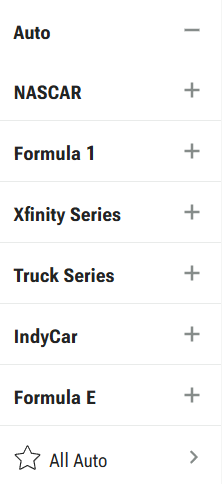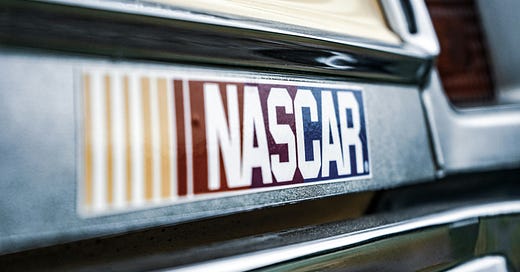So, you’re wondering how to bet on NASCAR. Maybe you’re new to sports betting and are wondering how to apply your NASCAR knowledge, or perhaps you’re new to NASCAR and are wondering how wagering on motorsports may differ from, say, stick-and-ball sports.
Before we dive into specifics, let me tell you that there are few sweats as fun as a NASCAR outright bet over the final laps of a race if you’ve got action on one of the first few drivers. A last-lap pass, late-race restart, or a freak mechanical failure are all in play.
A race is never over until it’s over, and those last laps are typically some of the best.
As we tackle how to bet on NASCAR, I want you to keep the following golden rule in mind. You should only place a bet—on NASCAR or otherwise—when you can spot a meaningful edge (read: advantage over the sportsbooks) on a betting market you understand.
How to Bet on NASCAR at Your Sportsbook
But before you can spot an edge or start thinking about a market, you must, well, find the NASCAR section of your sportsbook. This may sound obvious, but different books use different language.
Start by using your book’s toolbar. If you spot “NASCAR” (like you will do at BetMGM), you’ve got it. If you don’t, look for “Motorsports” (DraftKings and FanDuel) or “Auto” (Caesars).

Can’t find it? That might be by design. NASCAR betting markets will generally shut down during practice, qualifying, and support events. You may not be able to place a Cup Series bet during an Xfinity Series race.
Speaking of the support series—Make sure you’re wagering on the correct market. Generally, books will label events by series. They may also just refer to each event by its official name (Daytona 500, Food City 500, Xfinity 300, etc.).
Further, make sure you’re not wagering on the series championship market when you want to bet on a specific race.
Understanding the NASCAR Betting Markets
The most popular NASCAR betting market? Outrights, or the eventual race winner. On their face, these markets are simple: If your driver crosses the finish line first on the final lap, you’ll win.
But if you’re only playing the outright markets, you’re missing out on a ton of potential edge.
Most sportsbooks generally offer top-3 (or podium), top-5, or top-10 markets. Some, like Caesars, have experimented with top-20 markets.
In addition to betting on a driver to finish at or above a set position, you can also bet on them to edge on competing drivers. Generally, these markets are called either “matchups”/“head-to-heads” (two drivers) or “groups” (four drivers).
Drivers are not the only thing you can bet on, either. Most books will take action on the winning manufacturer (of which there are three) or the range of the winning driver’s number (think over/under).
The final variable you need to know is, well, time. Some books allow you to bet on where a driver will finish in a specific stage of the race. They may also allow you to bet on where a driver will start the race—before qualifying.
You may also see bets for the total number of cars to finish on the lead lap, the total number of cautions, and other novelty lines.
Finding an Edge on the NASCAR Betting Markets
You can find an edge when betting on NASCAR in a variety of different ways, and I break some of my favorites down in my NASCAR betting strategy guide. That said, when you are calculating your edge, you must start with an understanding of the price of every bet.
Let’s start with a math lesson. If there are 36 drivers entered in a given Cup Series event, a driver’s raw outright odds (assuming all cars, starting position, pit crews—things that certainly won’t be equal) are equal to 1÷36, also written as 35-1, +3500, or 2.7%.
Importantly, this doesn’t mean that no outright bet priced shorter than +3500 is a bad bet. Likewise, it doesn’t mean that any outright bet priced longer than +3500 is a good bet. Those are just reference points for which your edge must make up.
Let’s say your projections give Driver A a 25% chance of winning and Driver B a 10% chance of winning. You may think that means Driver A is always the better bet, but that isn’t the case.
Driver A must be priced at a line longer than +300 to be a good bet, while Driver B has some more wiggle room at +900. If Driver A is +250 while Driver B is +1200, you’d want to have your action on Driver B—even if your projections say Driver A is a clear favorite.
Raw Odds for the Primary NASCAR Betting Markets
*Assume only 36 entries. You can calculate raw odds on your own by dividing the number of drivers who cash by the number of entries.
Projections are not the only source of edge. You can instead use the market to find one by comparing the lines across different sportsbooks.
Let’s say Sportsbook A has Driver A priced at +400, Sportsbook B has the same driver priced at +500, Sportsbook C has him or her at +300, and Sportsbook D is at +1200.
If we assume that each book’s line is just as efficient as every other line, the average would come out to +476, or 17.3%. That would give us 9.6% of edge on Sportsbook D and 0.6% at Sportsbook B—but -7.7% of edge at Sportsbook A and -2.7 at Sportsbook C.





